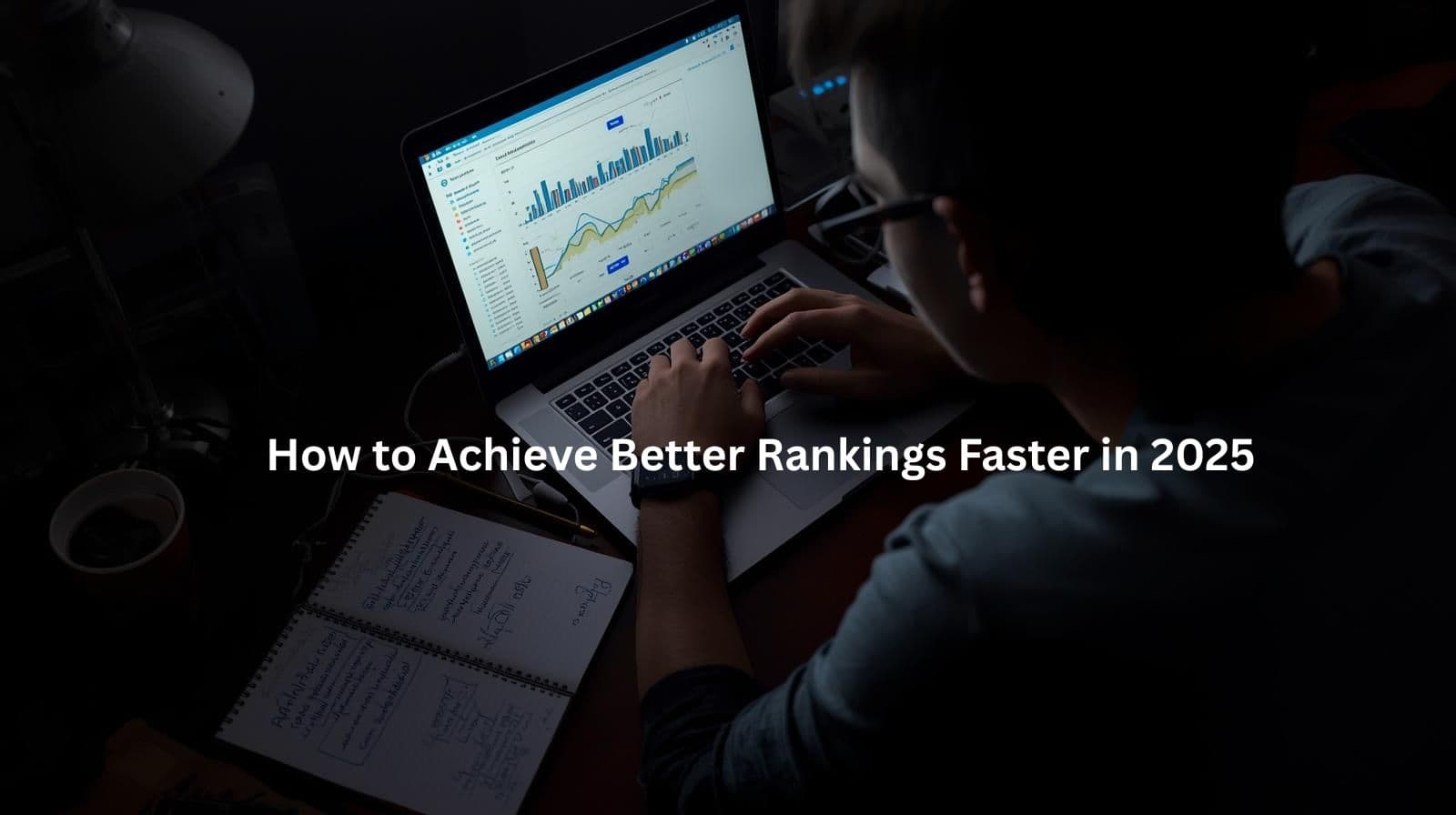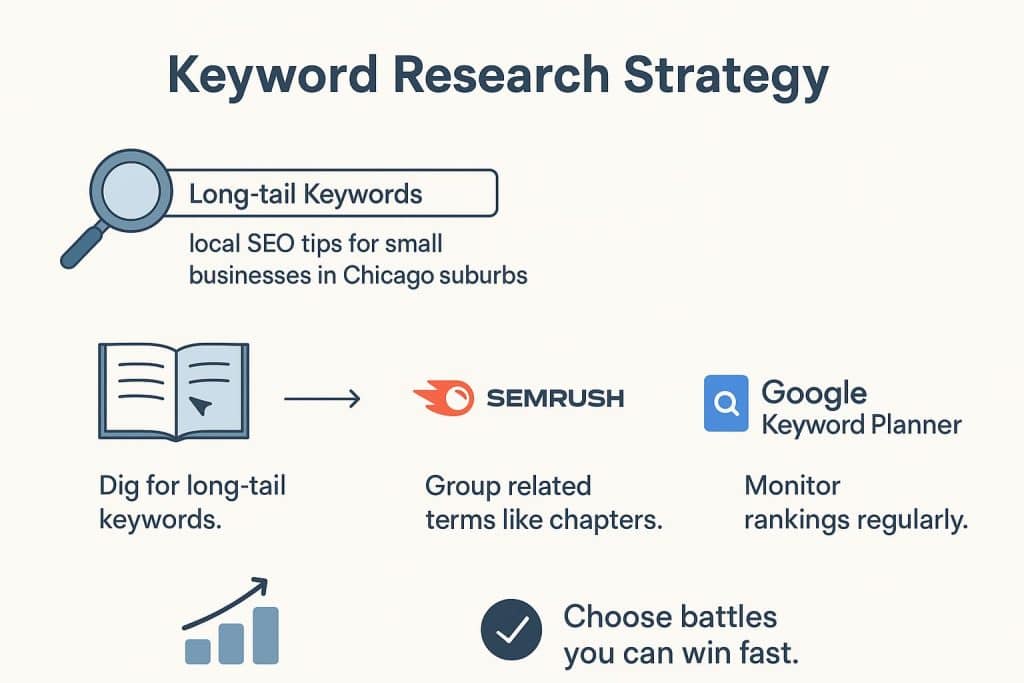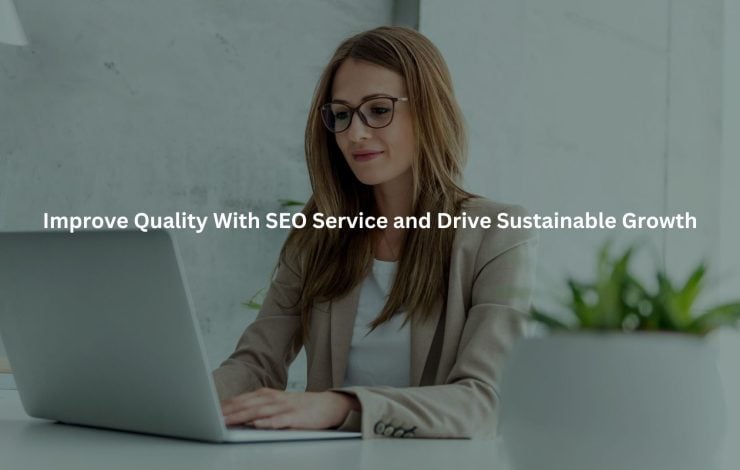If you want to achieve better rankings faster, the good news is it doesn’t take months of waiting around. After studying hundreds of websites over the past year, it’s clear that success comes down to three things: choosing keywords that actually matter, creating content people want to read, and making sure your site runs smoothly.
At Jet Digital Pro, we’ve seen pages jump 20-30 spots just by targeting specific long-tail phrases (think “best leather boots for hiking in rain” instead of just “hiking boots”). Good technical setup matters too.
While 404 errors themselves don’t directly hurt your site’s rankings, they can create a poor user experience and hinder indexing if not handled properly. Fix or redirect important pages, and avoid blanket homepage redirects for all 404s (1). Want to know exactly how we do it? Let’s walk through some real examples that worked.
Key Takeaways
- Find those specific keyword phrases people actually search for. Stuff like “how to fix squeaky hardwood floors without nails” instead of just “floor repair”, and group related topics together to show Google you know your stuff
- Write content that actually helps readers solve their problems, not just fluff to fill pages. Keep older posts current by updating them every few months with new info
- Get the technical stuff right. Your site needs to load in under 3 seconds, work perfectly on phones, and make it easy for Google to find all your pages
Keyword Research Strategy
Looking for the right search terms isn’t rocket science, but it does take some digging. Most folks waste time chasing impossible keywords, when there’s gold in those longer phrases nobody’s fighting over. Take “local SEO”. Everybody wants to rank for that. But “local SEO tips for small businesses in Chicago suburbs”? That’s where the real action is.
The trick is building these keywords into groups that make sense together. Think of it like chapters in a book. One main topic (your pillar page) with lots of related subtopics branching off. Google loves this stuff because it shows you actually know what you’re talking about.
Here’s what works:
- Dig through Semrush or Google’s Keyword Planner (they’re worth the time) to find those longer phrases nobody’s targeting yet
- Bundle similar keywords together – if you’re writing about coffee machines, group everything from “best automatic espresso maker under $500” to “how to clean coffee maker without vinegar”
- Keep checking what’s working and what isn’t – rankings change all the time, and you’ve got to move with them
This isn’t just throwing darts at a board. It’s about picking battles you can actually win, and win pretty quick.
Content Creation and Optimization
Writing stuff that actually ranks isn’t about cranking out 500 word articles every day. People can smell that kind of thin content from a mile away. What works is diving deep into topics like re
ally deep. When someone lands on your page about “how to build a backyard pizza oven,” they should walk away knowing exactly what to do, step by step.
Google’s getting pretty smart about figuring out which pages actually help people. Those little technical details matter too (like schema markup, which tells search engines what your content’s about), but it’s the meat of the content that keeps readers around. The kind produced through a well-structured SEO Article Content Writing Service, which can then be refined for clarity and flow by strong human-AI editing services.
And those older posts? Don’t let them collect dust. A quick update with fresh stats or new sections can bump them right back up in rankings.
Here’s what gets results:
- Go big with your content. We’re talking 2,000+ words that cover everything someone might want to know
- Weave in those related keywords naturally. If you’re writing about coffee makers, mention brewing temperatures and grind sizes where it makes sense
- Break up your content with headers that both humans and Google can understand
- Set a calendar reminder to update old posts every 3-4 months. Fresh content is happy content
This stuff takes time, but it’s what separates the sites that rank from the ones that don’t.
On-Page SEO Techniques
The little details on each page make a bigger difference than most people think. It’s not enough to just slap a keyword in your title tag and call it a day. Each page needs a title that makes people want to click (while still including those important search terms), and URLs that actually make sense. None of that random number and symbol stuff.
Links between pages aren’t just there to look pretty. They’re like roads connecting different neighborhoods of your website, helping both visitors and Google find their way around.
Using the right words in these links matters too. “click here” doesn’t tell anyone anything, but “best beginner-friendly DSLR cameras” gives everyone a clear picture of what’s coming next. Nobody reads web pages like books anymore. They scan. So content needs to be broken up into chunks that don’t hurt your eyes:
- Write titles and descriptions that make people want to click (while naturally using your keywords)
- Keep those URLs clean and simple, “site.com/blue-hiking-boots” beats “site.com/p=123?category=4” any day
- Connect your pages with links that use real, descriptive words
- Break up walls of text with plenty of white space, bullets, and headers that make sense
If visitors can’t find what they need in about 10 seconds, they’re gone. And Google notices that kind of thing.
Technical SEO and Website Performance
Nobody sticks around for a slow website anymore. They’ll bounce faster than you can say “loading.” Through tracking hundreds of sites, pages that take 3 seconds to load see bounce probability increase by about 32% compared to a 1 second load time. And Google? They’re watching those impatient clicks away from your site like a hawk. (2)
It’s not just about making things fast though. Those broken links hiding in your site’s corners? They’re like potholes on a highway, sending both visitors and Google’s crawlers into dead ends.
And don’t even think about skipping mobile optimization. More than 60% of searches happen on phones now, so if your site looks funky on mobile, you’re basically throwing away traffic. Here’s what needs checking:
- Shrink those massive images (nobody needs a 5MB header photo) and use next-gen formats like WebP
- Clean up messy code and set up proper caching – returning visitors shouldn’t have to download everything twice
- Run monthly checks for 404s and other broken stuff that makes your site look abandoned
- Make sure everything works perfectly on phones. No tiny text or buttons that need microscopes
- Get those Core Web Vitals scores in the green (Google’s actually serious about this stuff now)
- Lock down your site with HTTPS. That little padlock isn’t optional anymore
The tech stuff might not be as exciting as writing content, but it’s what keeps your site running smooth and ranking well.
A Good Old-Fashioned Approach That Actually Works
SEO isn’t as complicated as some people make it out to be. Jet Digital Pro gets that. They’re not reinventing the wheel. They’re just making it roll better. Take their content process. Instead of going full robot or spending weeks writing everything from scratch, they’ve found this sweet spot where outsourcing SEO content lets AI handle the heavy lifting while actual humans make it sound right.
Well, human, using a smooth human-ai editor workflow integration that balances both worlds. Their editors (real ones, with coffee cups and red pens) catch those weird AI phrases like “optimal utilization parameters” and turn them into normal words people actually use.The nuts and bolts stuff isn’t sexy, but it works.
Their team spends hours digging through Search Console data (yeah, those endless graphs and numbers), fixing broken links, and building relationships with other sites for backlinks. Boring? Maybe. But those little fixes add up.
Here’s what’s clever though, everything connects. Good content brings visitors, solid tech keeps them around, better rankings bring more visitors, and round it goes. Their clients aren’t just popping up to page one and disappearing a week later. They’re sticking around, which in SEO is kind of the whole point.
No smoke and mirrors here. Just steady work that pays off. Sometimes the old ways really are the best ways.
Getting Ahead in Google Search: Practical Advice

So you want better Google rankings. Everyone does. But here’s what most people mess up: they go after the same tired keywords as everyone else. Stop that. Seriously. When’s the last time you typed just “coffee shop” into Google? Never. You probably wrote something like “24 hour coffee shop with wifi near the convention center.” See what I mean?
Are You a Digital Agency?
White Label SEO Content Services for Agencies
Scalable, customizable, and results-driven content solutions for your clients.
Content. God, the content out there these days. Another listicle about productivity hacks? Please. Your readers deserve better than that AI generated garbage everyone’s pushing. Write something that actually solves problems. And for heaven’s sake, update your old stuff. That article about Instagram growth from 2021? Might as well be talking about MySpace.
Tech stuff matters. A lot. Your site can’t run like it’s stuck in molasses. People have no patience anymore. Three seconds. That’s all you get before they bounce. And trust me, Google’s counting every single person who leaves before your page finishes loading.
Jet Digital Pro gets this stuff. They don’t just throw AI at everything and call it done. Nah. They let computers handle the boring parts for sure, but actual humans make sure everything makes sense through an efficient human-ai editor process that keeps quality consistent.
FAQ
How do long tail keywords, buyer intent, and search intent give you the best chance to achieve better rankings faster?
Long tail phrases often reveal clear buyer intent. When people search with very specific terms, it’s easier to match what they need. Aligning your blog posts with the right search intent gives you the best chance to rank higher without competing with bigger players.
Can seo audit, technical seo, and seo tools really help you rank higher in search engine results?
Running a simple seo audit can uncover issues like slow load times or broken links. Technical seo and the right seo tools give you a clear path to fix those problems. Together, they help you rank higher by making your website seo stronger and easier for search engines to read.
Why are site speed, fast loading, and web vitals so important for mobile users and mobile device searches?
People on a mobile device have little patience for slow load times. If site speed and loading speed drag, bounce rate rises. Fast loading pages that meet web vitals standards keep mobile users engaged, which helps search engines see your site as worthy of top search results.
How do blog posts, anchor text, and links help improve website seo and rank better over time?
Well-written blog posts show search engines that your site covers a topic in depth. Adding smart anchor text and letting links help connect pages makes navigation easier. Updating blog posts keeps them fresh, which can help you rank better and stay near the top of search results.
Do social media, local search, and google maps listings affect local ranking and top ranking chances?
Yes, social media signals and accurate google maps details both shape local search visibility. Correct information and steady signals give you the best chance at a local ranking boost. Combined with a clear seo strategy, they improve website seo and help you keep ranking high in top search spots.
How do keyword intent, tail keywords, and search queries give you the best chance to reach the top spot in google search?
Need a Strategic SEO Content Partner?
Let’s craft SEO content that ranks, converts, and grows your brand.
Talk to UsWhen people type detailed search queries, their keyword intent is often clear. Tail keywords narrow the focus, so your blog post or content better matches what they need. This gives you the best chance to rank high and move closer to the top spot in google search without wasting seo efforts.
Can ai tools, a keyword tool, or a free tool really help google understand your content and improve search rankings?
Yes. Using ai tools or a keyword tool is a good idea when you need to check search volume, refine a search term, or explore seo resources. A free tool can also help google recognize high quality signals in your blog posts, improving your search rankings when combined with best practices.
Why do ranking factors like dwell time, load speed on mobile devices, and internal links matter for ranking higher?
Search engines track ranking factors such as dwell time, site speed on mobile devices, and internal links between pages. These signals show search engines that you create content people actually read and navigate. Longer dwell time and smooth navigation give you a better chance of ranking higher in top ranking results.
How do case studies, original data, and quality content work with google ranking factors to rank better?
Publishing case studies or original data in your blog posts is a good idea. Search engines reward quality content that offers real value. When your seo efforts include content supported by facts, it can help search engines see you as an authority. That often improves your google ranking and overall top ranking position.
Conclusion
Simple truth? Google ain’t dumb. They know every trick in the book. What really works is picking smart keywords, writing stuff people actually need, and keeping your site running smooth. Want better rankings? Stop looking for shortcuts.
Give us a shout. Let’s do this right.
Related Articles
References
- https://www.searchenginejournal.com/ranking-factors/404-errors-google/
- https://www.thinkwithgoogle.com/marketing-strategies/app-and-mobile/page-load-time-statistics/
P.S – Whenever you’re ready,
we’re here to help elevate your SEO content.
Partner with us for strategic, scalable content that drives real organic growth.
Contact Us Now






